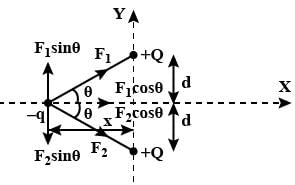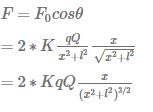Class 12 Exam > Class 12 Questions > Two identical positive charges are fixed on t...
Start Learning for Free
Two identical positive charges are fixed on the y-axis, at equal distances from the origin O. A particle with a negative charge starts on the x-axis at a large distance from O, moves along the +x-axis, passes through O and moves far away from O. Its acceleration a is taken as positive along its direction of motion. The particle's acceleration a is plotted against its x-coordinate. Which of the following best represents the plot ?
- a)
- b)
- c)
- d)
Correct answer is option 'B'. Can you explain this answer?
Verified Answer
Two identical positive charges are fixed on the y-axis, at equal dista...

Consider the attached free body diagram for the given scenario.
From coulomb's law,
∣F1∣=∣F2∣= qQ /4πεor2
In y-direction, forces cancel, Fy=0
In x-direction, forces add up. Also, it is directed in +ve x direction if the position of −q is along −ve x axis and in −ve x direction if the position of −q is along +ve x axis.
Hence,
Fx=2qQcosθ i /4πεor2 ∀ x<0
Fx=2qQcosθ i /4πεor2 ∀ x≥0
But cosθ =x/r
r= √x2+d2
Substituting in force equation, we get
Fx=2qQx i /4πεo( x2+d2)3/2 ∀ x<0
Fx=2qQx i /4πεo( x2+d2)3/2 ∀ x≥0
Now, a=F/m by Newton's second law. It is positive when x is negative and negative when x is positive. This is satisfied only in option (B).
Most Upvoted Answer
Two identical positive charges are fixed on the y-axis, at equal dista...
When particle is to the left of the origin O, the net force F on it is towards O and hence causes acceleration a.


F is zero for large values of x and also for x=0.Thus it must increase to a maximum and fall to zero at 0. The accleration a=F/m must have the same nature. To the right of O the net force is to the left while motion is to the right. Thhus the direction of a is opposite to the particle's direction of motion and is taken as negetive. The variation of F with x will follow the same pattern as a with x.
Free Test
FREE
| Start Free Test |
Community Answer
Two identical positive charges are fixed on the y-axis, at equal dista...

Consider the attached free body diagram for the given scenario.
From coulomb's law,
∣F1∣=∣F2∣= qQ /4πεor2
In y-direction, forces cancel, Fy=0
In x-direction, forces add up. Also, it is directed in +ve x direction if the position of −q is along −ve x axis and in −ve x direction if the position of −q is along +ve x axis.
Hence,
Fx=2qQcosθ i /4πεor2 ∀ x<0
Fx=2qQcosθ i /4πεor2 ∀ x≥0
But cosθ =x/r
r= √x2+d2
Substituting in force equation, we get
Fx=2qQx i /4πεo( x2+d2)3/2 ∀ x<0
Fx=2qQx i /4πεo( x2+d2)3/2 ∀ x≥0
Now, a=F/m by Newton's second law. It is positive when x is negative and negative when x is positive. This is satisfied only in option (B).

|
Explore Courses for Class 12 exam
|

|
Question Description
Two identical positive charges are fixed on the y-axis, at equal distances from the origin O. A particle with a negative charge starts on the x-axis at a large distance from O, moves along the +x-axis, passes through O and moves far away from O. Its acceleration a is taken as positive along its direction of motion. The particle's acceleration a is plotted against its x-coordinate. Which of the following best represents the plot ?a)b)c)d)Correct answer is option 'B'. Can you explain this answer? for Class 12 2025 is part of Class 12 preparation. The Question and answers have been prepared according to the Class 12 exam syllabus. Information about Two identical positive charges are fixed on the y-axis, at equal distances from the origin O. A particle with a negative charge starts on the x-axis at a large distance from O, moves along the +x-axis, passes through O and moves far away from O. Its acceleration a is taken as positive along its direction of motion. The particle's acceleration a is plotted against its x-coordinate. Which of the following best represents the plot ?a)b)c)d)Correct answer is option 'B'. Can you explain this answer? covers all topics & solutions for Class 12 2025 Exam. Find important definitions, questions, meanings, examples, exercises and tests below for Two identical positive charges are fixed on the y-axis, at equal distances from the origin O. A particle with a negative charge starts on the x-axis at a large distance from O, moves along the +x-axis, passes through O and moves far away from O. Its acceleration a is taken as positive along its direction of motion. The particle's acceleration a is plotted against its x-coordinate. Which of the following best represents the plot ?a)b)c)d)Correct answer is option 'B'. Can you explain this answer?.
Two identical positive charges are fixed on the y-axis, at equal distances from the origin O. A particle with a negative charge starts on the x-axis at a large distance from O, moves along the +x-axis, passes through O and moves far away from O. Its acceleration a is taken as positive along its direction of motion. The particle's acceleration a is plotted against its x-coordinate. Which of the following best represents the plot ?a)b)c)d)Correct answer is option 'B'. Can you explain this answer? for Class 12 2025 is part of Class 12 preparation. The Question and answers have been prepared according to the Class 12 exam syllabus. Information about Two identical positive charges are fixed on the y-axis, at equal distances from the origin O. A particle with a negative charge starts on the x-axis at a large distance from O, moves along the +x-axis, passes through O and moves far away from O. Its acceleration a is taken as positive along its direction of motion. The particle's acceleration a is plotted against its x-coordinate. Which of the following best represents the plot ?a)b)c)d)Correct answer is option 'B'. Can you explain this answer? covers all topics & solutions for Class 12 2025 Exam. Find important definitions, questions, meanings, examples, exercises and tests below for Two identical positive charges are fixed on the y-axis, at equal distances from the origin O. A particle with a negative charge starts on the x-axis at a large distance from O, moves along the +x-axis, passes through O and moves far away from O. Its acceleration a is taken as positive along its direction of motion. The particle's acceleration a is plotted against its x-coordinate. Which of the following best represents the plot ?a)b)c)d)Correct answer is option 'B'. Can you explain this answer?.
Solutions for Two identical positive charges are fixed on the y-axis, at equal distances from the origin O. A particle with a negative charge starts on the x-axis at a large distance from O, moves along the +x-axis, passes through O and moves far away from O. Its acceleration a is taken as positive along its direction of motion. The particle's acceleration a is plotted against its x-coordinate. Which of the following best represents the plot ?a)b)c)d)Correct answer is option 'B'. Can you explain this answer? in English & in Hindi are available as part of our courses for Class 12.
Download more important topics, notes, lectures and mock test series for Class 12 Exam by signing up for free.
Here you can find the meaning of Two identical positive charges are fixed on the y-axis, at equal distances from the origin O. A particle with a negative charge starts on the x-axis at a large distance from O, moves along the +x-axis, passes through O and moves far away from O. Its acceleration a is taken as positive along its direction of motion. The particle's acceleration a is plotted against its x-coordinate. Which of the following best represents the plot ?a)b)c)d)Correct answer is option 'B'. Can you explain this answer? defined & explained in the simplest way possible. Besides giving the explanation of
Two identical positive charges are fixed on the y-axis, at equal distances from the origin O. A particle with a negative charge starts on the x-axis at a large distance from O, moves along the +x-axis, passes through O and moves far away from O. Its acceleration a is taken as positive along its direction of motion. The particle's acceleration a is plotted against its x-coordinate. Which of the following best represents the plot ?a)b)c)d)Correct answer is option 'B'. Can you explain this answer?, a detailed solution for Two identical positive charges are fixed on the y-axis, at equal distances from the origin O. A particle with a negative charge starts on the x-axis at a large distance from O, moves along the +x-axis, passes through O and moves far away from O. Its acceleration a is taken as positive along its direction of motion. The particle's acceleration a is plotted against its x-coordinate. Which of the following best represents the plot ?a)b)c)d)Correct answer is option 'B'. Can you explain this answer? has been provided alongside types of Two identical positive charges are fixed on the y-axis, at equal distances from the origin O. A particle with a negative charge starts on the x-axis at a large distance from O, moves along the +x-axis, passes through O and moves far away from O. Its acceleration a is taken as positive along its direction of motion. The particle's acceleration a is plotted against its x-coordinate. Which of the following best represents the plot ?a)b)c)d)Correct answer is option 'B'. Can you explain this answer? theory, EduRev gives you an
ample number of questions to practice Two identical positive charges are fixed on the y-axis, at equal distances from the origin O. A particle with a negative charge starts on the x-axis at a large distance from O, moves along the +x-axis, passes through O and moves far away from O. Its acceleration a is taken as positive along its direction of motion. The particle's acceleration a is plotted against its x-coordinate. Which of the following best represents the plot ?a)b)c)d)Correct answer is option 'B'. Can you explain this answer? tests, examples and also practice Class 12 tests.

|
Explore Courses for Class 12 exam
|

|
Signup for Free!
Signup to see your scores go up within 7 days! Learn & Practice with 1000+ FREE Notes, Videos & Tests.


















